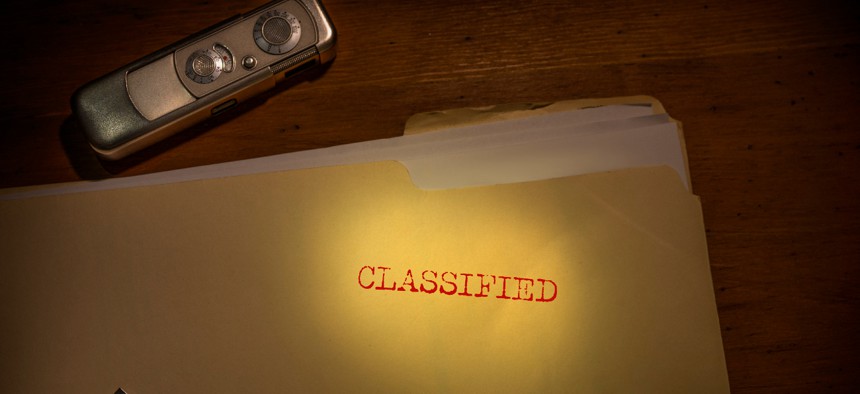Here's What Can Happen When the Average Clearance Holder Mishandles Classified Information
It very, very rarely results in security clearance denial and revocation.
Over the past several weeks news stories about the government’s classification process have abounded following the Aug. 8 search warrant exercised on former President Donald Trump’s Mar-a-Lago residence, which allegedly resulted in at least a few classified documents being removed by FBI agents searching the home.
The weeks since have resulted in a lot of pontifications around classification procedures, how information is classified, and what, if any, ramifications Trump will incur if the materials were in fact classified. Those questions are ones that will likely need to be sorted out in court and take months or years. The crux of the issue will be if the documents were taken to Mar-a-Lago before or after he left office, if they were declassified by him, or if they were potentially declassified by Trump and then reclassified by President Joe Biden – which will all likely depend on what the documents are in the first place (but before you get excited about reading them, keep in mind that current clearance holders or federal employees are barred from viewing anything that remains classified, even if it somehow ends up in the public square or published on the pages of a newspaper – that’s a lesson some clearance holders have learned the hard way following the Wikileaks exposures).
For the average security clearance applicant, the question around what will happen if you mishandle classified information is much more straightforward. Handling protected information (Guideline K) is one of the 13 adjudicative guidelines used to deny clearance eligibility, and often comes down to individuals who mishandled classified information.
One doesn’t have to speculate about the types of actions that will result in a denial or revocation based on Guideline K – or why the government takes such violations so seriously – the guideline states: “Deliberate or negligent failure to comply with rules and regulations for protecting classified or other sensitive information raises doubt about an individual’s trustworthiness, judgment, reliability, or willingness and ability to safeguard such information, and is a serious security concern.”
Mishandling classified information very, very rarely results in security clearance denial and revocation. In the year 2021, there were just three security clearance denials or revocations based on Guideline K, handling protected information.
Denials or revocations of clearance eligibility often come down to intentional violations, or repeated negligence. Anyone who has worked in a Sensitive Compartmentalized Information Facility probably knows someone who made a mistake around classification procedures at some point – incorrectly storing or filing something, failing to lock something, or other violations will sometimes occur. Like many things in the security clearance process, the response to the violation is in many cases as important as the violation itself. Many cases of clearance denials or revocations involving Guideline K also included two other adjudicative guidelines: Personal Conduct, and/or Misuse of Information Technology Systems.
Here are some specific examples of incidents involving classified information that resulted in a clearance denial or revocation:
- The applicant left a building unsecure; kept combinations to two safes written on a piece of paper in his wallet; and failed to “double-wrap” sensitive material during its transport. The judge noted the applicant’s “carelessness and inattention to established procedures” when charged with the protection of sensitive material.
- The applicant, as the last person to leave the office at night, failed to properly secure the lock before leaving; the applicant downloaded classified information he thought to be unclassified onto the company’s Wide Area Network.
- The applicant “deliberately concealed misuse of an unclassified [employer-issued] computer …This misuse included surfing the Internet, looking at stock quotes, and buying things….A coworker mentioned in passing that a security officer had advised that personal use of the computer was unauthorized. [Applicant] deliberately did not follow the guidance …because he believed it was too rigid and rationalized he did not know what the real policy was…”
In all of these cases, you’ll note the violations were repeated, or multi-layered. It isn’t the one-time security violation that typically results in a security clearance denial or revocation. And like most things, there are steps individuals can take to mitigate potential negative repercussions.
If you find you have accidentally mishandled classified information:
- Report it to your security officer.
- Take relevant training offered by the Center for Development of Security Excellence and ensure proof of completion is provided to your security officer.
Taking steps to report, rectify, and take responsibility for any violations of security policy are critical in ensuring continued access to classified information. Because willful violation of security policies can be a key indication of a counterintelligence threat, the government tends to look at security violations with particular sensitivity. Mitigating a security violation often requires demonstrating why the behavior is unlikely to reoccur, or because the violation took place under unusual or unexpected circumstances.
Unfortunately, ignorance of policies or procedures is not frequently an adequate mitigator. The government is more likely to look favorably on an applicant who admits guilt or mishandling of information, and then takes steps to receive further training or education around classification procedures, or the specific element of security policy that was violated. Mistakes happen – even with a job as important as protecting classified information. But what matters is accepting responsibility for any incidents that occur, and being transparent about it.







